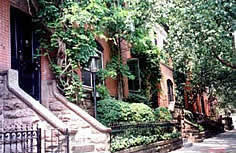
 |
||||||




| "Development
that enhances the character of our historic districts is encouraged.
We recognize that change is an important element in the city's evolution,
an indicator of a healthy, vital neighborhood, and reflects the
pride of residents in their community." |
Benefits of Local Historic Districts
![]() Local
districts protect the investments of owners and residents. Buyers
know that the aspects that make a particular area attractive will be protected
over a period of time. Real estate agents in many cities use historic
district status as a marketing tool to sell properties.
Local
districts protect the investments of owners and residents. Buyers
know that the aspects that make a particular area attractive will be protected
over a period of time. Real estate agents in many cities use historic
district status as a marketing tool to sell properties.
![]() Local
districts encourage better design. It has been shown through comparative
studies that there is a greater sense of relatedness, more innovative
use of materials, and greater public appeal within historic districts
than in areas without historic designations.
Local
districts encourage better design. It has been shown through comparative
studies that there is a greater sense of relatedness, more innovative
use of materials, and greater public appeal within historic districts
than in areas without historic designations.
![]() Local
districts help the environment. Historic district revitalization
can, and should, be part of a comprehensive environmental policy.
Local
districts help the environment. Historic district revitalization
can, and should, be part of a comprehensive environmental policy.
![]() The educational benefits of creating local
districts are the same as those derived from any historic preservation
effort. Districts help explain the development of a place, the source
of inspiration, and technological advances. They are a record of ourselves
and our communities.
The educational benefits of creating local
districts are the same as those derived from any historic preservation
effort. Districts help explain the development of a place, the source
of inspiration, and technological advances. They are a record of ourselves
and our communities.
![]() A
local district can result in a positive economic impact from tourism.
A historic district that is aesthetically cohesive and well promoted can
be a community's most important attraction. The retention of historic
areas as a way to attract tourist dollars makes good economic sense.
A
local district can result in a positive economic impact from tourism.
A historic district that is aesthetically cohesive and well promoted can
be a community's most important attraction. The retention of historic
areas as a way to attract tourist dollars makes good economic sense.
![]() The
protection of local historic districts can enhance business recruitment
potential. Companies continually re-locate to communities that
offer their workers a higher quality of life, which is greatly enhanced
by successful local preservation programs and stable historic districts.
The
protection of local historic districts can enhance business recruitment
potential. Companies continually re-locate to communities that
offer their workers a higher quality of life, which is greatly enhanced
by successful local preservation programs and stable historic districts.
![]() Local
districts provide social and psychological benefits. A sense of
empowerment and confidence develops when community decisions are made
through a structured participatory process rather than behind closed doors
or without public comment.
Local
districts provide social and psychological benefits. A sense of
empowerment and confidence develops when community decisions are made
through a structured participatory process rather than behind closed doors
or without public comment.
---------------------------------
Excerpted and adapted from Maintaining Community Character: How to Establish a Local Historic District by Pratt Cassity. National Trust for Historic Preservation. 2000.